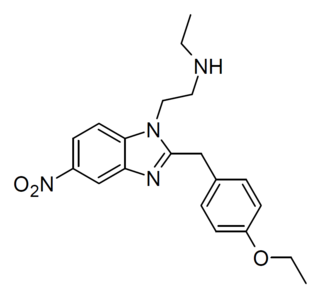
Etonitazene, also known as EA-4941 or CS-4640, is a benzimidazole opioid, first reported in 1957, that has been shown to have approximately 1,000 to 1,500 times the potency of morphine in animals.

Eutylone is a stimulant and empathogenic compound developed in the 1960s, which is classified as a designer drug. It was first reported to the EMCDDA in 2014 and became widespread internationally in 2019-2020 following bans on the related compound ephylone. It is not a natural, but a synthetic cathinone. In 2021, eutylone was the most common cathinone identified by the Drug Enforcement Administration in the United States.

U-47700, also known as U4, pink heroin, pinky, and pink, is an opioid analgesic drug developed by a team at Upjohn in the 1970s which has around 7.5 times the potency of morphine in animal models.

Bucinnazine is an opioid analgesic drug that was widely used in China to treat pain in cancer patients as of 1986. It is one of the most potent compounds among a series of piperazine-amides first synthesized and reported in Japan in the 1970s. Bucinnazine has analgesic potency comparable to that of morphine but with a relatively higher therapeutic index.

Metonitazene is an analgesic compound related to etonitazene, which was first reported in 1957, and has been shown to have approximately 1000 times the potency of morphine by central routes of administration, but if used orally it has been shown to have approximately 10 times the potency of morphine.

Isotonitazene is a benzimidazole-derived opioid analgesic drug related to etonitazene, which has been sold as a designer drug. It has only around half the potency of etonitazene in animal studies, but it is likely even less potent in humans as was seen with etonitazene. Isotonitazene was fully characterized in November 2019 in a paper where the authors performed a full analytical structure elucidation in addition to determination of the potency at the μ-opioid receptor using a biological functional assay in vitro. While isotonitazene was not compared directly to morphine in this assay, it was found to be around 2.5 times more potent than hydromorphone and slightly more potent than fentanyl.

Brorphine is a piperidine-based opioid analgesic compound. Brorphine was originally discovered in a 2018 paper investigating functionally biased opioid compounds, with the intention of finding safer analgesics that produce less respiratory depression than typical opioids. Brorphine was originally reported to be highly biased, with an EC50 of 4.8nM for GTPγS binding and 182nM for β-arrestin recruitment, however a more recent study found no significant bias for any of the compounds tested, including brorphine. Its safety profile in any animal model has never been established. Despite the lack of safety information on the compound, brorphine has been sold as a designer drug since mid-2019, initially being identified in the US Midwest, though it has since been found in 2020 in Belgium. It is related in chemical structure to compounds such as benzylfentanyl and bezitramide, though it is sufficiently structurally distinct to fall outside the formal definition of a "fentanyl analogue" in jurisdictions such as the US and New Zealand which have Markush structure controls over this family of drugs.

Etodesnitazene is a benzimidazole derived opioid analgesic drug, which was originally developed in the late 1950s alongside etonitazene and a range of related derivatives. It is many times less potent than etonitazene itself, but still 70x more potent than morphine in animal studies. Corresponding analogues where the N,N-diethyl group is replaced by piperidine or pyrrolidine rings also retain significant activity. Etodesnitazene has been sold as a designer drug, first being identified in both Poland and Finland in March 2020.

AP-238 is an opioid designer drug related to drugs such as azaprocin and bucinnazine, with around the same potency as morphine. It was first discovered in Italy in the 1960s but was never marketed, subsequently appearing on the illicit market around 2020 and being detected in both Slovenia and the USA.

Etonitazepipne is a benzimidazole derivative with opioid effects around 100 times more potent than morphine, which has been sold over the internet as a designer drug.

Metodesnitazene is a benzimidazole derivative with opioid effects, though unlike related compounds such as metonitazene and etodesnitazene which are many times more potent, metodesnitazene is only around the same potency as morphine in animal studies. It was proposed by the DEA to be placed under legal control in the US in December 2021.

Protonitazene is a benzimidazole derivative with potent opioid effects which has been sold over the internet as a designer drug since 2019, and has been identified in various European countries, as well as Canada, the US and Australia. It has been linked to numerous cases of drug overdose, and is a Schedule I drug in the US.

Butonitazene is a benzimidazole derivative with opioid effects, which has been sold over the internet as a designer drug. It has relatively low potency compared to many related compounds, and has generally been encountered as a component of mixtures with other substances rather than in its pure form. However, it is still several times the potency of morphine and has been implicated in several cases of drug overdose. Butonitazene is a Schedule I drug in the US, along with several related compounds.

N-Desethylisotonitazene (Norisotonitazene) is a benzimidazole derivative with potent opioid effects which has been sold as a designer drug. It was first identified as an active metabolite of the related compound isotonitazene, but was unexpectedly found to be similar potency compared to the parent compound, and is among the most potent opioid agonists in this family, around 20 times stronger than fentanyl. It has become an increasingly widespread drug of abuse in its own right, linked to numerous cases of drug overdose,and may be considered an analog of a schedule 1 drug in the US. On October 25 an intent to temporarily schedule Etonitazepipne and N-desethyl Isotonitazene was published. So on November 24 a month after publishing intent, it will most likely be placed in schedule 1.

N-Desethyletonitazene is a benzimidazole derivative with potent opioid effects which has been sold as a designer drug. It is better known as an active metabolite of the related compound etonitazene, but has similar activity to the parent compound and has sometimes appeared as a drug of abuse in its own right.

3,4-MDO-U-47700 is an opioid analgesic which has been sold as a designer drug, first appearing in 2017 after U-47700 itself was banned in various jurisdictions. It is less potent than U-47700 but is still a full agonist at the μ-opioid receptor, with slightly higher potency than morphine. It is illegal in Virginia.

U-48800 is an opioid analgesic which has been sold as a designer drug. Unlike U-47700, it is primarily active as a kappa opioid receptor agonist with only moderate affinity at the mu opioid receptor. Nevertheless, it has still appeared on the recreational drug market, often as a component of combinations with other drugs, and has been linked to numerous drug overdose cases.
Utopioids are a class of synthetic opioid analgesic drugs first developed in the 1970s by the pharmaceutical company Upjohn. However, they were never marketed for medical use. Some compounds from this class have been used for scientific research as model kappa opioid receptor agonists. In the mid-2010s, one mu opioid receptor selective compound from this class, U-47700, re-emerged as a designer drug and became widely sold around the world for several years before being banned in various jurisdictions from 2016 onwards. Following the prohibition of U-47700, a number of related compounds have continued to appear on illicit drug markets. They are often marketed online or included as components in mixtures sold under the guise of "street heroin." U-47700 itself is the most potent mu opioid agonist from this class, around 7-10x the potency of morphine. Some other compounds such as 3,4-MDO-U-47700 and N-Ethyl-U-47700 retain similar mu selectivity but with lower potency similar to that of morphine, or have a mixture of mu and kappa mediated effects, such as U-48800. Most utopioid derivatives are however selective kappa agonists, which may have limited abuse potential as dissociative hallucinogens, but do not alleviate withdrawal distress in opioid dependent individuals or maintain addiction in a typical sense. Nevertheless, this has not stopped them from being sold as designer drugs, and a number of these compounds are now banned in many jurisdictions alongside U-47700 itself.

Flunitazene (Fluonitazene) is a benzimidazole derivative with opioid effects, first developed in the 1950s as part of the research that led to better-known compounds such as etonitazene. It is one of the least potent derivatives from this class to have appeared as a designer drug, with only around the same potency as morphine, but nevertheless has been sold since around 2020, and has been linked to numerous drug overdose cases.


















